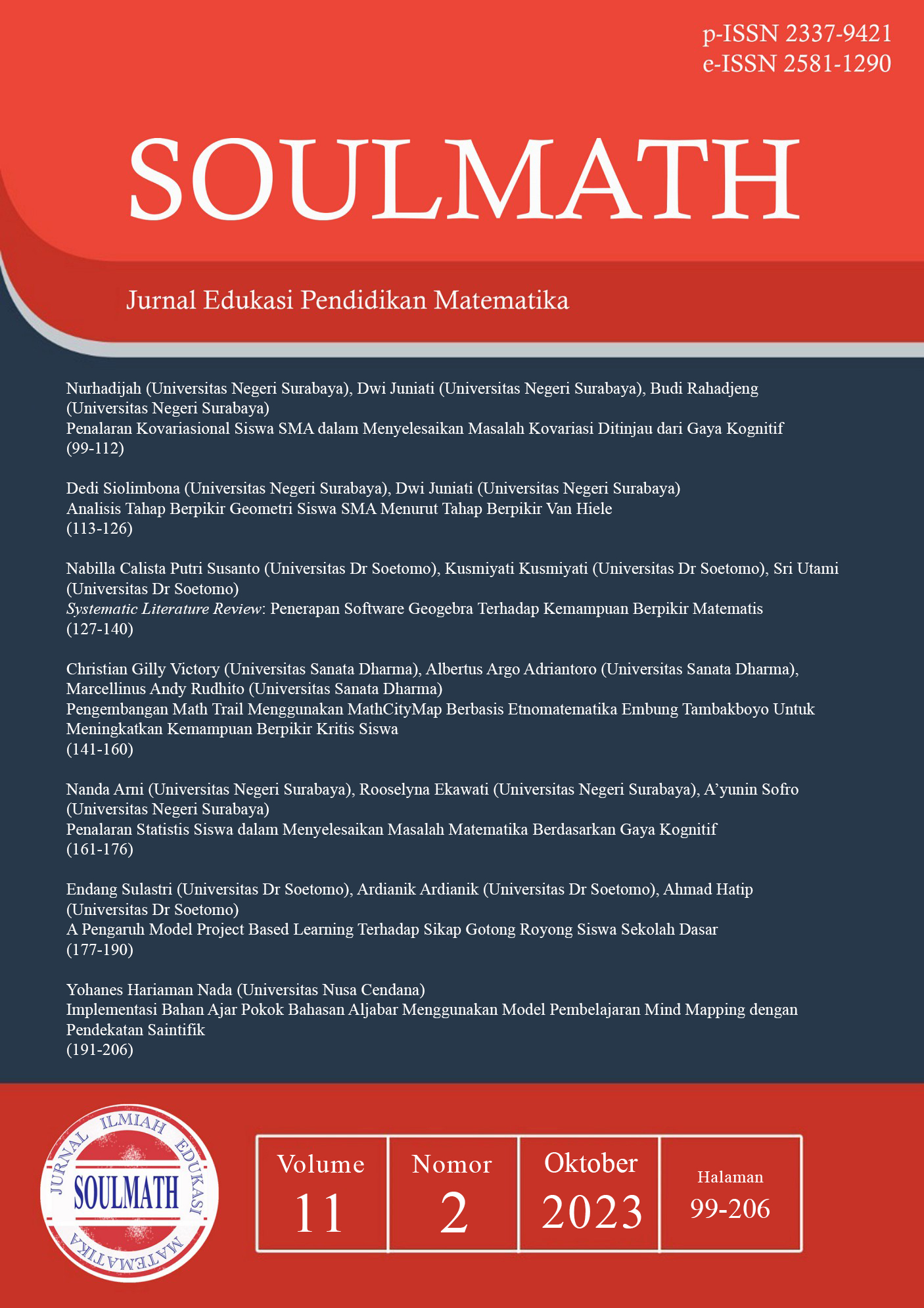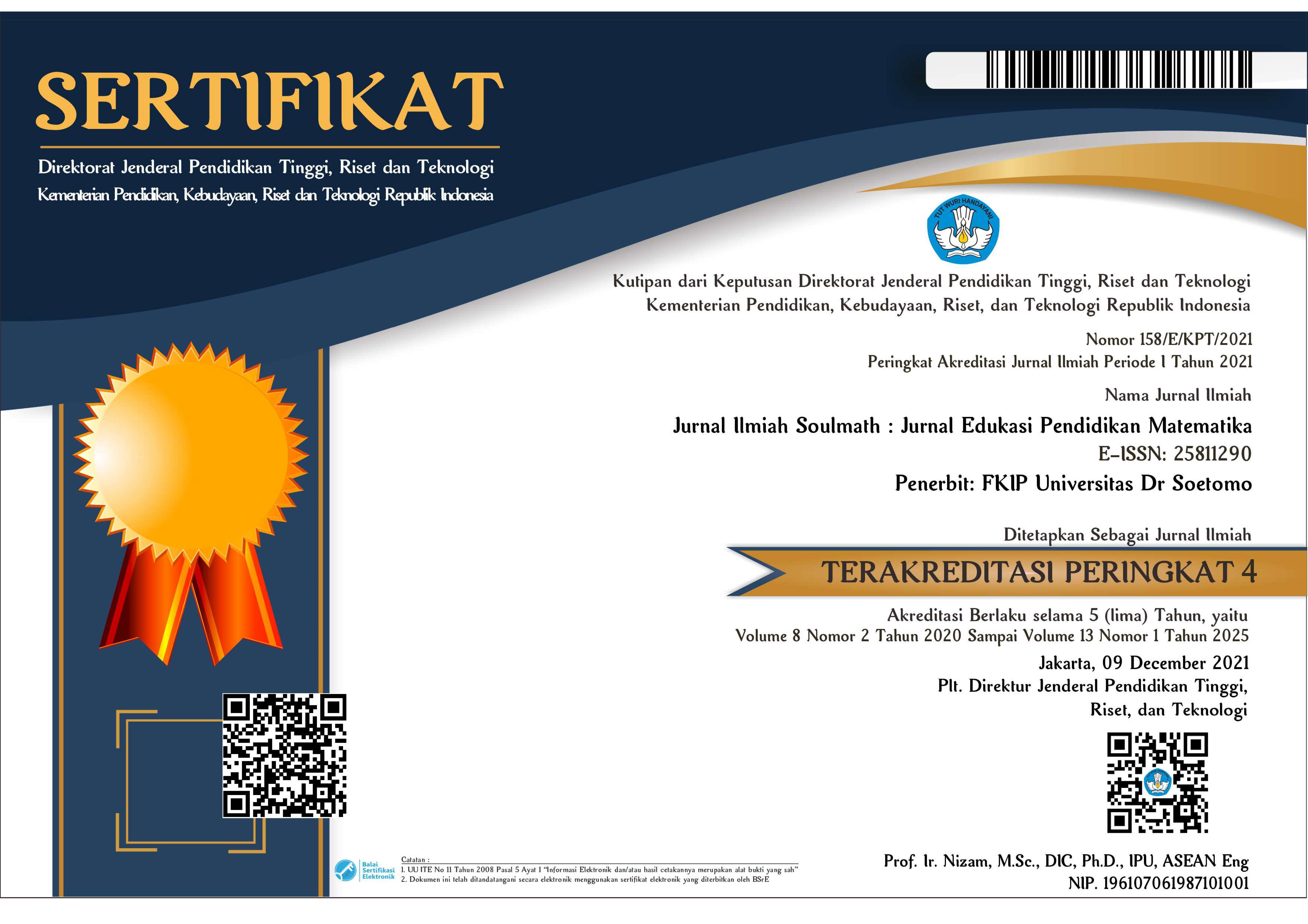Implementasi Bahan Ajar Pokok Bahasan Aljabar Menggunakan Model Pembelajaran Mind Mapping dengan Pendekatan Saintifik
 Abstract views: 224
,
Abstract views: 224
,
 6926 Publish (Bahasa Indonesia) downloads: 153
6926 Publish (Bahasa Indonesia) downloads: 153
Abstract
Mathematics is studied in Indonesia at all school levels because it is able to train students' problem-solving skills and meet practical demands. Teachers and students still face a lot of challenges in putting these strategies into practice, though. The fact that the course material did not adhere to the approaches and models that attracted and engaged students was one of the problems. The 2013 curriculum aims to develop productive, inventive, creative, and character-defining learners by integrating the development of attitudes, abilities, and knowledge. The mind-mapping learning paradigm has the power to inspire pupils, excite them, and pique their interest in the content they are studying. In order to create educational materials employing a mind mapping methodology with a scientific approach, developmental research is also required. A stage known as implementation is necessary for the proper production and distribution of the development material. This study concentrates on the implementation phase to evaluate the usefulness and potency of the information. In one of Kupang's upper secondary schools, the eighth grade saw the implementation of instructional materials. Based on the outcomes of the data analysis, it was determined that each meeting's criteria for teacher and student learning activity fell into the "good" and "very good" categories and satisfied requirements for practicality. According to the post-test findings, 76% of the students were deemed successful. Thus, it may be said that the instructional materials created are efectively.
Keywords: Educational Materials, Mind Mapping, Scientific Approaches
Downloads
References
D. D. Samo and B. Kartasasmita, “Developing Contextual Mathematical Thinking Learning Model to Enhance Higher-Order Thinking Ability for Middle School Students,” vol. 10, no. 12, pp. 17–29, 2017, doi: 10.5539/ies.v10n12p17.
S. Marfu’ah, Zaenuri, Masrukan, and Walid, “Model Pembelajaran Matematika untuk Meningkatkan Kemampuan Penalaran Matematis Siswa,” in Prosiding Seminar Nasional Matematika, 2022, pp. 50–54. [Online]. Available: https://journal.unnes.ac.id/sju/index.php/prisma/
R. Wahyu, Y. Putra, P. Indriani, and A. Info, “Implementasi Etnomatematika Berbasis Budaya Lokal dalam Pembelajaran Matematika pada Jenjang Sekolah Dasar,” Numer. J. Mat. dan Pendidik. Mat., vol. 1, no. 1, pp. 9–14, 2017.
F. F. Said, A. Susanto, and N. P. Utami, “Pengembangan Lembar Kerja Peserta Didik (LKPD) Berbantuan Canva yang Efektif,” J. Ilm. Soulmath J. Edukasi Pendidik. Mat., vol. 11, no. 1, pp. 85–98, 2023, doi: 10.25139/smj.v11i1.6020.
E. K. Hasibuan, “Analisis Kesulitan Belajar Matematika Siswa Pada Pokok Bahasan Bangun Ruang Sisi Datar Di Smp Negeri 12 Bandung,” AXIOM J. Pendidik. dan Mat., vol. 7, no. 1, pp. 18–30, 2018, doi: 10.30821/axiom.v7i1.1766.
R. Tianingrum and H. N. Sopiany, “Analisis Kemampuan Pemahaman Matematis Siswa SMP Pada Materi Bangun Ruang Sisi Datar,” Anal. Kemamp. Pemahaman Mat. Siswa, pp. 440–446, 2017, [Online]. Available: http://pmat-unsika.eu5.org/Prosiding/64RisnaTianingrum-SESIOMADIKA-2017.pdf
J. Y. Kharisma and A. Asman, “Pengembangan Bahan ajar Matematika Berbasis Masalah Berorientasi pada Kemampuan Pemecahan Masalah Matematis dan Prestasi Belajar Matematika,” Indones. J. Math. Educ., vol. 1, no. 1, pp. 34–46, 2018.
Ibrahim, “Pengembangan Bahan Ajar Matematika Sekolah Berbasis Masalah Terbuka untuk Memfasilitasi Pencapaian Kemampuan Berpikir Kritis dan Kreatif Matematis Siswa,” Pros. Semin. Nas. UNY, vol. 6, no. 3, pp. 121–132, 2011.
A. L. Mowendu, Slameto, and Y. Dwikurnaningsih, “Evaluasi Implementasi Kurikulum 2013 pada Mata Pelajaran Matematika Di SMP Negeri,” Kelola J. Manaj. Pendidik., vol. 6, no. 1, pp. 74–88, 2019, doi: 10.24246/j.jk.2019.v6.i1.p74-88.
N. G. Kustian, “Penggunaan Metode Mind Mapping Dalam Meningkatkan Hasil Belajar Siswa,” Acad. J. Inov. Ris. Akad., vol. 1, no. 1, pp. 30–37, 2021, doi: 10.51878/academia.v1i1.384.
R. Ananda, “Penerapan Metode Mind Mapping Untuk Meningkatkan Kemampuan Berpikir Kreatif Siswa Sekolah Dasar,” Edukatif J. Ilmu Pendidik., vol. 1, no. 1, pp. 1–10, 2019, doi: 10.31004/edukatif.v1i1.1.
T. Buzan, Buku Pintar Mind Map, 1st ed. Jakarta: Gramedia Pustaka Utama, 2006.
J. R. Bajracharya, “Instructional Design and Models: ASSURE and Kemp,” J. Educ. Res., vol. 9, no. 2, pp. 1–8, 2019, doi: 10.3126/jer.v9i2.30459.
M. P. Dr. E. Kosasih, Pengembangan Bahan ajar, 1st ed. Jakarta: PT. Bumi Aksara, 2021.
S. Arikunto, Prosedur Penelitian: Suatu Pendekatan Praktek. Jakarta: Rineka Cipta, 2001.
Restu Rahayu et al, “Pengembangan LKPD untuk Meningkatkan Kemampuan Pemecahan Masalah Matematika : Systematic Literature Review,” J. basicedu, vol. 5, no. 4, pp. 2541–2549, 2021.
D. Swadarma, Penerapan Mind Mapping dalam Kurikulum Pembelajaran. Jakarta: PT. Elex Media Komputindo, 2013.
R. Y. Gazali, “Pengembangan Bahan Ajar Matematika untuk Siswa SMP berdasarkan Teori Belajar Ausubel,” PYTHAGORAS J. Pendidik. Mat., vol. 11, no. 2, p. 182, 2016, doi: 10.21831/pg.v11i2.10644.







